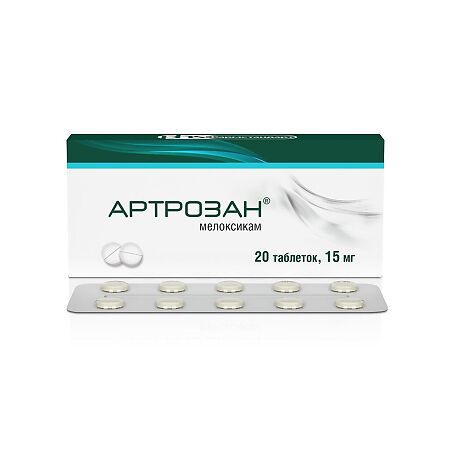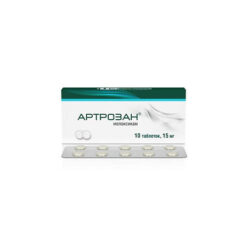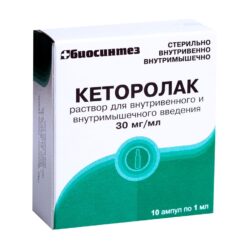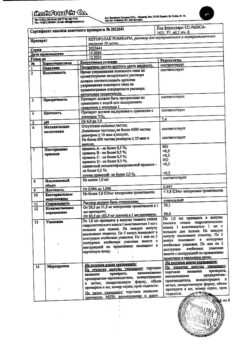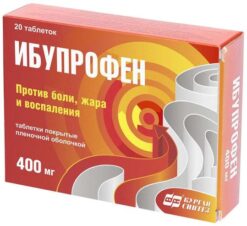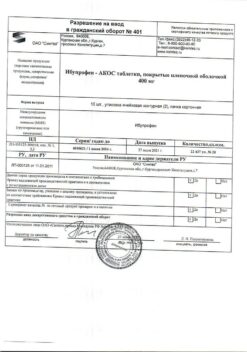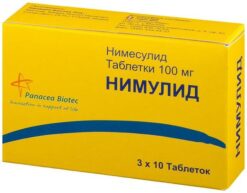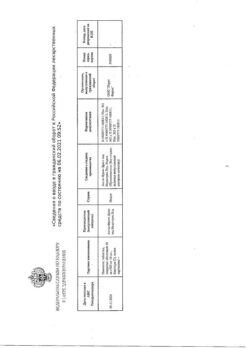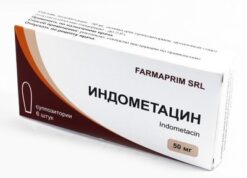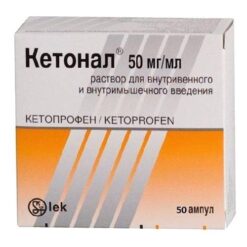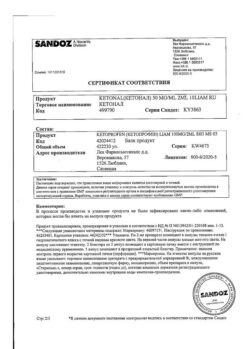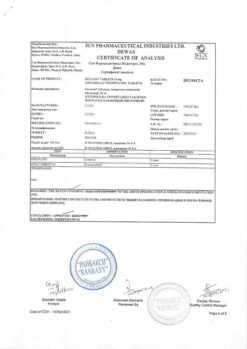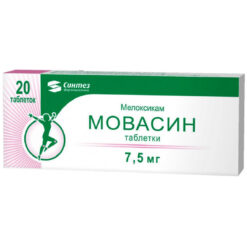No products in the cart.
Arthrozan, tablets 15 mg 20 pcs
€10.94 €9.57
Description
Pharmacotherapeutic group: Non-steroidal anti-inflammatory drug
ATX code: M01AC06
Pharmacological properties
Pharmacodynamics
Artrosan
sup>® is a non-steroidal anti-inflammatory drug (NSAID) with anti-inflammatory, antipyretic and analgesic effects.
It belongs to the class of oxycams and is a derivative of enolic acid.
The mechanism of action is related to inhibition of prostaglandin synthesis due to selective inhibition of enzymatic activity of cyclooxygenase of the second type (COX-2), which takes part in biosynthesis of prostaglandins in inflammatory areas. When prescribed in high doses, prolonged use and individual characteristics of the body, selectivity against COX-2 is reduced. To a lesser extent, it acts on cyclooxygenase type 1 (COX-1), which is involved in the synthesis of prostaglandins that protect the mucosa of the gastrointestinal tract and is involved in the regulation of blood flow in the kidneys. Due to the above selective inhibition of COX-2 activity, the drug less often causes erosive-ulcerative lesions of the gastrointestinal tract.
Pharmacokinetics
Highly absorbed from the gastrointestinal tract, the absolute bioavailability is 89%. Simultaneous intake of food does not change the absorption of the drug. When using the drug orally in doses of 7.5 and 15 mg, its concentrations are proportional to the doses. Equilibrium concentrations are reached within 3-5 days of treatment. In long-term use of the drug (more than 1 year) concentrations are similar to those observed after the first achievement of steady state pharmacokinetics.
Binding to plasma proteins is 99%. At a dose of 7.5 mg, the minimum concentration (Cmin) is 0.4 µg/mL, the maximum concentration (Cmax) is 1.0 µg/mL; when using a 15 mg dose, Cmin is 0.8 µg/mL, Cmax is 2.0 µg/mL. It is almost completely metabolized in the liver to form four pharmacologically inactive derivatives. The main metabolite, 5′-carboxymeloxicam (60% of the dose value), is formed by oxidation of the intermediate metabolite, 5′-hydroxymethylmeloxicam, which is also excreted, but to a lesser extent (9% of the dose value). In vitro studies have shown that CYP 2C9 isoenzyme plays an important role in this metabolic transformation, CYP3A4 isoenzyme has additional importance. Peroxidase plays an important role in the formation of the other two metabolites (which are, respectively, 16% and 4% of the drug dose), whose activity probably varies.
The drug penetrates through the histohematic barriers, the concentration in the synovial fluid is 50% of the maximum concentration in plasma.
Plasma clearance is on average 8 ml/min. In elderly persons the drug clearance is decreased. The volume of distribution is low and averages 11 L. Hepatic or renal insufficiency of moderate severity has no significant effect on the pharmacokinetics of meloxicam.
It is excreted in equal proportions in the feces and urine, mainly as metabolites. Less than 5% of the daily dose is excreted unchanged in the intestine, the drug is detected only in trace amounts in the urine. The half-life (T1/2) of meloxicam is 15-20 hours.
Indications
Indications
Symptomatic therapy:
osteoarthritis (arthrosis, degenerative joint diseases), including with a pain component;
rheumatoid arthritis;
ankylosing spondylitis.
Pharmacological effect
Pharmacological effect
Pharmacotherapeutic group: non-steroidal anti-inflammatory drug
ATC code: M01AC06
Pharmacological properties
Pharmacodynamics
Artrosan® is a nonsteroidal anti-inflammatory drug (NSAID) with anti-inflammatory, antipyretic and analgesic effects.
Belongs to the class of oxicams, is a derivative of enolic acid.
The mechanism of action is associated with inhibition of prostaglandin synthesis as a result of selective inhibition of the enzymatic activity of type 2 cyclooxygenase (COX-2), involved in the biosynthesis of prostaglandins in the area of inflammation. When prescribed in high doses, long-term use and individual characteristics of the body, selectivity for COX-2 decreases. To a lesser extent, it affects cyclooxygenase type 1 (COX-1), which is involved in the synthesis of prostaglandins that protect the mucous membrane of the gastrointestinal tract and take part in the regulation of blood flow in the kidneys. Due to the indicated selectivity of suppressing the activity of COX-2, the drug is less likely to cause erosive and ulcerative lesions of the gastrointestinal tract.
Pharmacokinetics
Well absorbed from the gastrointestinal tract, absolute bioavailability is 89%. Concomitant food intake does not alter the absorption of the drug. When using the drug orally in doses of 7.5 and 15 mg, its concentrations are proportional to the doses. Equilibrium concentrations are achieved within 3-5 days of treatment. With long-term use of the drug (more than 1 year), concentrations are similar to those observed after the first achievement of a steady-state pharmacokinetic state.
Plasma protein binding is 99%. When using a dose of 7.5 mg, the minimum concentration (Cmin) is 0.4 μg/ml, the maximum concentration (Cmax) is 1.0 μg/ml; when using a dose of 15 mg, Cmin is 0.8 μg/ml, Cmax is 2.0 μg/ml. Almost completely metabolized in the liver to form four pharmacologically inactive derivatives. The main metabolite, 5′-carboxymeloxicam (60% of the dose), is formed by oxidation of an intermediate metabolite, 5′-hydroxymethylmeloxicam, which is also excreted, but to a lesser extent (9% of the dose). In vitro studies have shown that the CYP2C9 isoenzyme plays an important role in this metabolic transformation, and the CYP3A4 isoenzyme is of additional importance. In the formation of the other two metabolites (constituting, respectively, 16% and 4% of the dose of the drug), peroxidase takes part, the activity of which probably varies.
The drug penetrates histohematic barriers, the concentration in the synovial fluid is 50% of the maximum concentration in plasma.
Plasma clearance averages 8 ml/min. In elderly people, drug clearance is reduced. The volume of distribution is low, averaging 11 liters. Hepatic or renal failure of moderate severity does not have a significant effect on the pharmacokinetics of meloxicam.
Excreted in equal proportions with feces and urine, mainly in the form of metabolites. Less than 5% of the daily dose is excreted unchanged through the intestines; the drug is found unchanged in urine only in trace amounts. The half-life (T1/2) of meloxicam is 15-20 hours.
Special instructions
Special instructions
Caution should be exercised when using the drug in patients with a history of gastric and duodenal ulcers, and in patients on anticoagulant therapy. Such patients have an increased risk of erosive and ulcerative diseases of the gastrointestinal tract.
Caution should be exercised and monitor daily diuresis and renal function when using the drug in the elderly and patients with reduced blood volume and reduced glomerular filtration (dehydration, chronic heart failure, cirrhosis of the liver, nephrotic syndrome, clinically significant kidney disease, taking diuretics, dehydration after major surgery).
In patients with a slight or moderate decrease in renal function (creatinine clearance 30-60 ml/min), no dose adjustment is required.
Patients taking diuretics and meloxicam simultaneously should take sufficient fluids.
If allergic reactions occur (itching, skin rash, urticaria, photosensitivity) during treatment, you should consult a doctor to decide whether to stop taking the drug.
Meloxicam, like other NSAIDs, can mask the symptoms of infectious diseases.
The use of meloxicam, like other drugs that block prostaglandin synthesis, can affect fertility and is therefore not recommended for women planning pregnancy.
Influence on the ability to drive vehicles and machinery
Due to the possibility of headache, dizziness and drowsiness, during the treatment period patients should refrain from driving vehicles and performing other potentially hazardous activities that require increased concentration and speed of psychomotor reactions.
Active ingredient
Active ingredient
Meloxicam
Composition
Composition
For 1 tablet:
active ingredient: meloxicam – 7.5 mg or 15.0 mg;
excipients:
for a dosage of 7.5 mg: potato starch – 64.5 mg, lactose monohydrate – 100.0 mg, povidone (polyvinylpyrrolidone, povidone K-25) – 3.2 mg, sodium citrate – 18.8 mg, magnesium stearate – 2.0 mg, colloidal silicon dioxide (aerosil) – 4.0 mg;
for a dosage of 15.0 mg: potato starch – 94.5 mg, lactose monohydrate – 150.0 mg, povidone (polyvinylpyrrolidone, povidone K-25) – 4.5 mg, sodium citrate – 27.0 mg, magnesium stearate – 3.0 mg, colloidal silicon dioxide (aerosil) – 6.0 mg.
Pregnancy
Pregnancy
The drug is contraindicated for use during pregnancy and breastfeeding. If it is necessary to use it during breastfeeding, the issue of stopping breastfeeding should be decided.
Contraindications
Contraindications
Hypersensitivity to meloxicam or auxiliary components of the drug;
heart failure in the stage of decompensation;
early postoperative period after coronary artery bypass grafting;
complete or incomplete combination of bronchial asthma, recurrent polyposis of the nose and paranasal sinuses and intolerance to acetylsalicylic acid or other NSAIDs (including a history);
exacerbation of peptic ulcer of the stomach and duodenum; active gastrointestinal bleeding;
inflammatory bowel diseases (ulcerative colitis, Crohn’s disease in the acute stage);
cerebrovascular bleeding or other bleeding;
severe liver failure or active liver disease;
chronic renal failure (in patients not undergoing hemodialysis (creatinine clearance less than 30 ml/min); progressive kidney disease, including confirmed hyperkalemia;
children under 15 years of age;
pregnancy;
breastfeeding period;
lactose intolerance, lactase deficiency and glucose-galactose malabsorption
With caution
The drug should be used with caution in elderly patients and with a history of the following conditions: ischemic heart disease, congestive heart failure, cerebrovascular disease, dyslipidemia/hyperlipidemia, diabetes mellitus, peripheral vascular disease, chronic renal failure with a creatinine clearance of 30-60 ml/min; ulcerative lesions of the gastrointestinal tract, the presence of Helicobacter pylori infection.
Long-term use of NSAIDs, alcohol abuse, concomitant therapy with anticoagulants (for example, warfarin), antiplatelet agents (for example, acetylsalicylic acid, clopidogrel), oral glucocorticosteroids (for example, prednisolone), selective serotonin reuptake inhibitors (for example, citalopram, fluoxetine, sertraline, paroxetine) should be mandatory be taken into account when prescribing meloxicam.
To reduce the risk of developing adverse events from the gastrointestinal tract, the minimum effective dose should be used in the shortest possible course.
Side Effects
Side Effects
Within system-organ classes, the following categories are used according to the frequency of side effects: very often (≥ 1/10); often (≥ 1/100, < 1/10); uncommon (≥ 1/1,000, < 1/100); rare (≥ 1/10,000, < 1/1,000); very rare (< 1/10,000); not installed.
Blood and lymphatic system:
uncommon: anemia;
rare: changes in the number of blood cells, including changes in the leukocyte formula, leukopenia, thrombocytopenia.
On the part of the immune system:
uncommon: other immediate hypersensitivity reactions;
frequency unknown: anaphylactic shock, anaphylactoid/anaphylactic reactions.
Psychologically:
often: mood changes;
frequency unknown: confusion, disorientation.
On the part of the nervous system:
often: headache;
uncommon: dizziness, drowsiness.
On the part of the organ of vision:
rare: conjunctivitis, visual disturbances, including blurred vision.
Disorders of the hearing organ and labyrinth:
uncommon: vertigo;
rare: tinnitus.
From the heart:
rare: palpitations.
From the blood vessels:
uncommon: increased blood pressure, flushing of blood to the face.
On the part of the respiratory system, chest and mediastinal organs:
rare: bronchial asthma in patients allergic to acetylsalicylic acid or other NSAIDs.
Gastrointestinal tract:
often: abdominal pain, dyspepsia, diarrhea, nausea, vomiting;
uncommon: hidden or obvious gastrointestinal bleeding, gastritis, stomatitis, constipation, bloating, belching;
rare: gastroduodenal ulcers, colitis, esophagitis;
very rare: perforation of the gastrointestinal tract.
From the liver and biliary tract:
uncommon: transient changes in liver function tests (for example, increased activity of transaminases or bilirubin);
very rare: hepatitis.
On the skin and subcutaneous tissues:
uncommon: angioedema, itching, skin rash;
rare: toxic epidermal necrolysis, Stevens-Johnson syndrome, urticaria;
very rare: bullous dermatitis, erythema multiforme;
frequency unknown: photosensitivity.
On the part of the kidneys and urinary tract:
uncommon: changes in renal function (increased levels of creatinine and/or urea in the blood serum), urinary disorders, including acute urinary retention;
very rare: acute renal failure.
Concomitant use with drugs that depress the bone marrow (for example, methotrexate) may cause cytopenia. Gastrointestinal bleeding, ulceration, or perforation can be fatal.
As with other NSAIDs, the possibility of interstitial nephritis, glomerulonephritis, renal medullary necrosis, and nephrotic syndrome cannot be excluded.
Interaction
Interaction
when used simultaneously with other non-steroidal anti-inflammatory drugs (including acetylsalicylic acid), the risk of erosive and ulcerative lesions and gastrointestinal bleeding increases;
when used simultaneously with antihypertensive drugs, the effectiveness of the latter may decrease;
with simultaneous use with lithium preparations, the development of cumulation of lithium and an increase in its toxic effect is possible (monitoring the concentration of lithium in the blood is recommended);
when used simultaneously with methotrexate, the side effect of the latter on the hematopoietic system increases (the risk of anemia and leukopenia, periodic monitoring of a general blood test is indicated);
when used simultaneously with diuretics and cyclosporine, the risk of developing renal failure increases;
when used simultaneously with intrauterine contraceptives, the effectiveness of the latter may decrease;
when used simultaneously with anticoagulants (heparin, warfarin), thrombolytic drugs (streptokinase, fibrinolysin), and antiplatelet agents (ticlopidine, clopidogrel, acetisalicylic acid), the risk of bleeding increases (periodic monitoring of blood clotting parameters is necessary);
when used simultaneously with cholestyramine, the elimination of meloxicam through the gastrointestinal tract is accelerated;
When used simultaneously with selective serotonin reuptake inhibitors, the risk of gastrointestinal bleeding increases.
NSAIDs should be started no earlier than 8–12 days after taking mifepristone, as NSAIDs may reduce the effectiveness of mifepristone.
Overdose
Overdose
Symptoms: impaired consciousness, nausea, vomiting, epigastric pain, bleeding in the gastrointestinal tract, acute renal failure, liver failure, respiratory arrest, asystole.
Treatment: there are no specific antidotes or antagonists. In case of an overdose of the drug – gastric lavage, taking activated charcoal (within the next hour), symptomatic therapy. Forced diuresis, alkalinization of urine, hemodialysis are ineffective due to the high binding of the drug to blood proteins.
Storage conditions
Storage conditions
Store at a temperature not exceeding 25 °C.
Keep out of the reach of children.
Shelf life
Shelf life
3 years.
Do not use after expiration date.
Manufacturer
Manufacturer
Pharmstandard-Leksredstva, Russia
Additional information
| Shelf life | 3 years. Do not use after the expiration date. |
|---|---|
| Conditions of storage | Store at the temperature not more than 25 °С. Keep out of reach of children. |
| Manufacturer | Pharmstandard-Leksredstva, Russia |
| Medication form | pills |
| Brand | Pharmstandard-Leksredstva |
Other forms…
Related products
Buy Arthrozan, tablets 15 mg 20 pcs with delivery to USA, UK, Europe and over 120 other countries.

